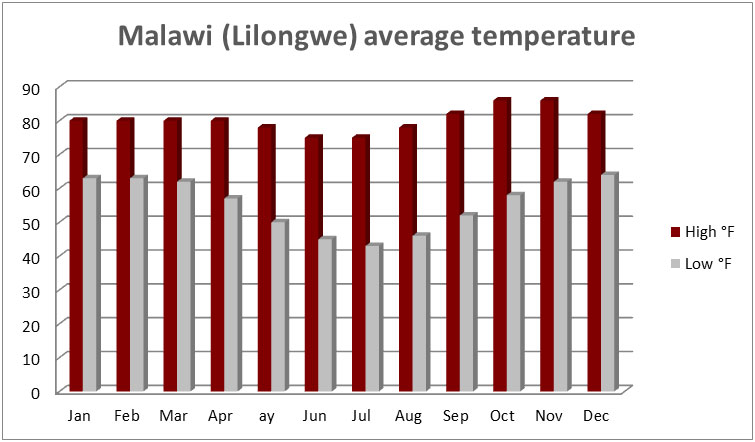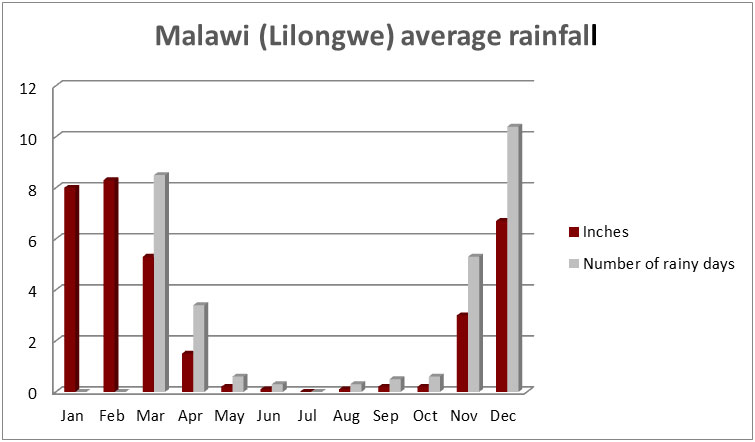Malawi is a friendly, land-locked country located in southern Africa, bordering Zambia, Mozambique and Tanzania. It is home to one of the largest freshwater lakes in the world, the beautiful Lake Malawi, with marvelous beaches and clear water, dotted with a huge variety of colorful fish (cichlids). The Lake is paradise for those wanting a little rest and relaxation after exploring Malawi’s exciting national wildlife parks, or climbing its tallest mountain, Mulanje. Malawi is well renowned for its friendly people, excellent quality tea (visit one of the wonderful tea estates for a tour) and easily accessible cultural experiences. There are several “Big Five” National Parks which have made enormous strides in the past 20 years to now compare favorably with better known safari destinations. The combination of water based and land safaris, makes Malawi an exciting and diverse destination. Birders will delight in the over 650 species that call it home at various times of the year. English is widely spoken, families are more than welcome, and those on a somewhat limited budget will really get excellent value for money.
- LOCATION Malawi is in southern Africa, east of Zambia and west of Mozambique.
- SIZE Malawi covers an area of 118,480 sq km, slightly smaller than Greece
- CAPITAL CITY Lilongwe is Malawi's capital city
- POPULATION Around 18 million people live in Malawi.
- LANGUAGES Chichewa (official) is the most common language spoken in Malawi. English is also used in business and government.
- THE FLAG The Malawi flag is a horizontal triband of black, red, and green; charged with a red rising sun with 31 rays centered on the black stripe. The rising sun represents the dawn of hope and freedom for the continent of Africa. The 31 rays of the sun represent the fact that Malawi was the 31st African nation at the time of its independence. The black represents the indigenous people of the continent, the red symbolizes the blood of their struggle, and the green represents nature.
- CURRENCY For safari purposes, the US Dollar $ is widely accepted at lodges and camps, but the local currency is the Malawi Kwacha
- GETTING TO MALAWI For safari destinations, the main points of entry are Lilongwe (LLW) or Blantyre (BLZ), served by South African Airways (to/from Johannesburg), Air Malawi, and Ethiopian Airways.
- COMBINE MALAWI WITH... Zambia, Zimbabwe, Mozambique and South Africa
- Download Before You Go ...
- BOOKS Venture to the Interior – Laurens van der Post, The Boy Who Harnessed the Wind - William Kamkwamba, From Microsoft to Malawi – Michael L. Buckler
- MOVIES Mercy’s Blessing (2015), The Boy Who Harnessed the Wind (2019), Buddha in Africa (2019), The Boy Who Flies (2013)
LAKE MALAWI
Lake Malawi is a beautiful freshwater lake that takes up nearly a third of the area of landlocked Malawi. Blessed with golden beaches and incredibly colorful varieties of fish, the lake offers very rewarding snorkeling and diving. The southern end of the lakeshore is very popular due to its proximity to the commercial capital, Blantyre. There are numerous bays to choose from and accommodations run from simple campsites and cottage rentals to the more luxurious Makakola Retreat and Pumulani. Cape Maclear on the southern end is a mecca for snorkeling and other water sports. (Note there is a risk of contracting the parasite bilharzia; make sure you know the symptoms of the disease and how to treat it.) Likoma Island at the northern end is home to the luxurious Kaya Mawa lodge, a firm favorite with Honeymooners.
MULANJE MOUNTAIN
Mulanje Mountain is located in southern Malawi 65 kilometers (40 miles) east of Blantyre; its highest peak Sapitwa reaches just above 3,000 meters (nearly 10,000 feet). There are plenty of hiking routes to choose from to enjoy this mountain, with simple huts at the end of each route. The best time to climb Mulanje is between May and October.
LIWONDE NATIONAL PARK
Liwonde National Park is Malawi's premier wildlife park with a lovely setting along the banks of the Shire River, where you can view hippo pods in the water and large herds of elephants on the side enjoying a drink and a splash. The park is 220 square miles and boasts impressive birdlife—you're very likely to see African Fish Eagles displaying their skills as well as the rare Pel's Fishing Owl. The best time to visit is during the cooler dry season from June to August, as Liwonde can get very hot and humid during the rains.
MAJETE WILDLIFE RESERVE
Majete lies in in the South West of Malawi, approximately 70km – (one and a half hour’s drive) from Blantyre’s Chileka International Airport and three hours from Lake Malawi. Majete was once a prolific wildlife refuge but by the late 1990’s most species of large game, including elephant, had been eradicated. Remnant populations of a few resilient species remained but they had been reduced to very low, and in some cases critical numbers. In 2003, African Parks Majete (APM) a non-profit organization, in partnership with the Malawian government and local communities, took total responsibility for the rehabilitation and long-term management of the reserve. By March 2012, 2,559 animals from fourteen different species had been reintroduced including the famed African ‘Big Five’: leopard, elephant, buffalo, black rhino and lion. Other mammals reintroduced were eland, sable, waterbuck, nyala, hartebeest, impala, zebra, warthog and bush pig and in late 2018, Majete received its first ever population of giraffe (thirteen in total). The introduced animals have been thriving and breeding well and current estimates put the total population of mammals over 11,000. Safari activities available to visitors include boat safaris on the magnificent Shire River, as well as safaris by vehicle and on foot.
ZOMBA PLATEAU
Zomba Plateau offers incredible views, waterfalls, dams filled with trout, and a lovely respite from the heat. The 6,000-foot plateau is located in Zomba, the lively former capital of Malawi. Most visitors will spend a day or a couple of nights and enjoy hikes along wooded paths; a favorite view is the "Queen's View." You can take horse rides down nice trails from the long-established Plateau Stables. The best way to get up to the plateau is by car or taxi; it's a long steep walk otherwise, and the rewarding hikes are really at the top of the mountain anyway. The nicest place to stay is the Sunbird Ku Chawe Inn at the mountain's edge.
THYOLO TEA ESTATES
Tea has been grown in Malawi since 1908 and the primly trimmed bushes (actually, trees) give the whole Thyolo (pronounced Cholo) area the appearance of a neatly kept huge garden. The Satemwa Tea Estate is probably the most popular to visit, with an intriguing history dating back a century. As well as plenty of opportunities for walks and hikes around the scenic estate, Satemwa offer tea tasting sessions where guests can visit the factory to learn how the tea is grown, dried and prepared ready to sip, followed by a wonderful display of a variety teas and pleasing aromas. The Thyolo Forest Reserve is also a haven for walkers and birdwatchers and offers a fantastic terrain for those wishing to pedal around on bicycles.
NYIKA NATIONAL PARK
Just over 60 years ago, the northwestern part of Malawi—an area of 1,250 square miles known as the Nyika National Park—was so unknown to the British (who were in charge at the time), that they sent explorer Laurens van der Post to report on it. He turned his mission to this vast escarpment into a best-selling book "Venture to the Interior," describing the beautiful high rolling hills of grasslands dotted with zebra, antelope, orchids, and butterflies that make Malawi's largest national park well worth visiting. Hiking, mountain biking, and horse riding are the principal activities here.
Malawi Suggested Safaris
Magical Malawi
13 Days 12 Nights$9000 - $11500You will start your exploration of Malawi with 3 nights of safari, after a quick 2 hour drive from Chileka Airport in Blantyre. You'll stay at Mkulumadzi luxury camp in the Majete Wildlife Reserve, and enjoy game drives as well as river cruises and walking safaris. With just 8 chalets in this large private concession you are guaranteed an amazing and unique wildlife experience. Your next stop is 2 nights at the Satemwa Tea Estate, a wonderful break in your safari journey. You can stretch your legs, taste some of the best tea on the planet, and cycle around the picturesque rows of tea bushes with Mount Mulanje as your backdrop. Liwonde is your next point of call, one of Malawi's premier national parks, is now home to a significant black rhino population as well as many other mammals including elephant, lion and cheetah. Kuthengo Camp is nestled among Fever trees and Baobabs on an open plain stretching towards the Shire River. Enjoy views from your private deck of the herds of waterbuck that frequent the camp area in the evenings. Day or night game drives are offered in open-top game-viewing vehicles, and guests can also go on bush walks. Boating on the lagoons is a special treat that can be enjoyed from the end of December to early April. After a week of safari, you'll be looking forward to your stay at Kaya Mawa, on the white sandy beaches of Likoma Island. "Kaya Mawa" translates as "Maybe Tomorrow"... the Likoma Island version of mañana... without the urgency. You can relax on pristine beaches, snorkel and dive in crystal-clear waters, as well as enjoy a variety of water sports.

